 W
WThe B28, originally Mark 28, was a thermonuclear bomb carried by U.S. tactical fighter bombers, attack aircraft and bomber aircraft. From 1962 to 1972 under the NATO nuclear weapons sharing program, American B28s also equipped six Europe-based Canadian CF-104 squadrons known as the RCAF Nuclear Strike Force. It was also supplied for delivery by UK-based Royal Air Force Valiant and Canberra aircraft assigned to NATO under the command of SACEUR. In addition, certain U.S. Navy carrier based attack aircraft such as the A3D Skywarrior, A4D Skyhawk, and A3J Vigilante were equipped to carry the B28.
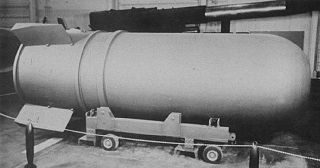 W
WThe B-41 was a thermonuclear weapon deployed by the United States Strategic Air Command in the early 1960s. It was the most powerful nuclear bomb ever developed by the United States, with a maximum yield of 25 megatons of TNT. The B-41 was the only three-stage thermonuclear weapon fielded by the U.S.
 W
WThe B43 was a United States air-dropped variable yield thermonuclear weapon used by a wide variety of fighter bomber and bomber aircraft.
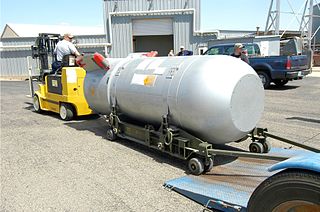 W
WThe Mk/B53 was a high-yield bunker buster thermonuclear weapon developed by the United States during the Cold War. Deployed on Strategic Air Command bombers, the B53, with a yield of 9 megatons, was the most powerful weapon in the U.S. nuclear arsenal after the last B41 nuclear bombs were retired in 1976.
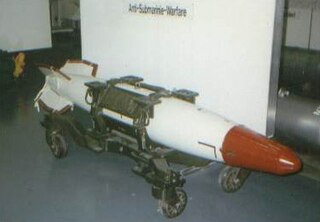 W
WThe B57 nuclear bomb was a tactical nuclear weapon developed by the United States during the Cold War.
 W
WThe B61 nuclear bomb is the primary thermonuclear gravity bomb in the United States Enduring Stockpile following the end of the Cold War. It is a low to intermediate-yield strategic and tactical nuclear weapon featuring a two-stage radiation implosion design.
 W
WThe B83 is a variable-yield thermonuclear gravity bomb developed by the United States in the late 1970s and entered service in 1983. With a maximum yield of 1.2 megatons, it is the most powerful nuclear weapon in the United States nuclear arsenal. It was designed by Lawrence Livermore National Laboratory.
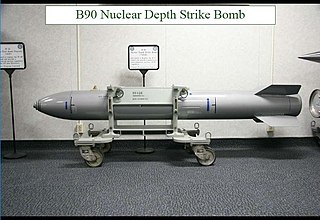 W
WThe B90 Nuclear Depth Strike Bomb (NDSB) was an American thermonuclear bomb designed at Lawrence Livermore National Labs in the mid-to-late 1980s and cancelled prior to introduction into military service due to the end of the Cold War.
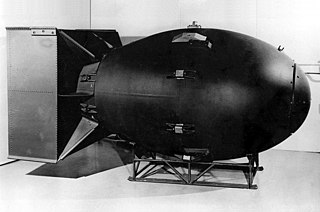 W
W"Fat Man" is the codename for the type of nuclear bomb that was detonated over the Japanese city of Nagasaki by the United States on 9 August 1945. It was the second of the only two nuclear weapons ever used in warfare, the first being Little Boy, and its detonation marked the third nuclear explosion in history. It was built by scientists and engineers at Los Alamos Laboratory using plutonium from the Hanford Site, and it was dropped from the Boeing B-29 Superfortress Bockscar piloted by Major Charles Sweeney.
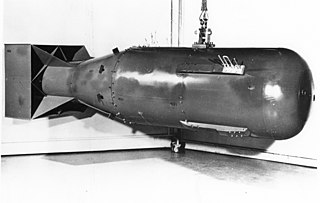 W
W"Little Boy" was the codename for the type of atomic bomb dropped on the Japanese city of Hiroshima on 6 August 1945 during World War II. It was the first nuclear weapon used in warfare. The bomb was dropped by the Boeing B-29 Superfortress Enola Gay piloted by Colonel Paul W. Tibbets, Jr., commander of the 509th Composite Group of the United States Army Air Forces and Captain Robert A. Lewis. It exploded with an energy of approximately 15 kilotons of TNT (63 TJ) and caused widespread death and destruction throughout the city. The Hiroshima bombing was the second man-made nuclear explosion in history, after the Trinity nuclear test.
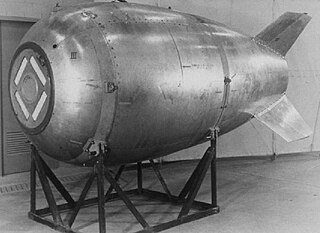 W
WThe Mark 4 nuclear bomb was an American implosion-type nuclear bomb based on the earlier Mark 3 Fat Man design, used in the Trinity test and the bombing of Nagasaki. With the Mark 3 needing each individual component to be hand-assembled by only highly trained technicians under closely controlled conditions, the purpose of the Mark 4 was to produce an atomic weapon as a practical piece of ordnance. The Mark 4 Mod 0 entered the stockpile starting March 19, 1949 and was in use until 1953. With over 500 units procured, the Mark 4 was the first mass-produced nuclear weapon.
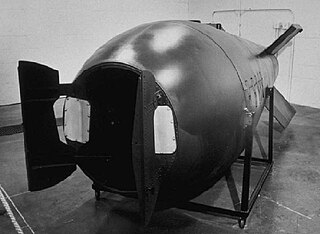 W
WThe Mark 5 nuclear bomb and W5 nuclear warhead were a common core American nuclear weapon design, designed in the early 1950s and which saw service from 1952 to 1963.
 W
WThe Mark 6 nuclear bomb was an American nuclear bomb based on the earlier Mark 4 nuclear bomb and its predecessor, the Mark 3 Fat Man nuclear bomb design.
 W
WMark 7 "Thor" was the first tactical fission bomb adopted by US armed forces. It was also the first weapon to be delivered using the toss method with the help of the low-altitude bombing system (LABS). The weapon was tested in Operation Buster-Jangle. To facilitate external carry by fighter-bomber aircraft, Mark 7 was fitted with retractable stabilizer fins. The Mark 7 warhead (W7) also formed the basis of the 30.5 inches (775 mm) BOAR rocket, the Mark 90 Betty nuclear depth charge, MGR-1 Honest John rocket, and MGM-5 Corporal ballistic missile. It was also supplied for delivery by Royal Air Force Canberra aircraft assigned to NATO in Germany under the command of SACEUR. This was done under the auspices of Project E, an agreement between the United States and the UK on the RAF carriage of US nuclear weapons. In UK use it was designated 1,650 lb. H.E. M.C. The Mark 7 was in service from 1952 to 1967(8) with 1700–1800 having been built.
 W
WThe Mark 8 nuclear bomb was an American nuclear bomb, designed in the late 1940s and early 1950s, which was in service from 1952 to 1957.
 W
WThe Mark 11 nuclear bomb was an American nuclear bomb developed from the earlier Mark 8 nuclear bomb in the mid-1950s. Like the Mark 8, the Mark 11 was an earth-penetrating weapon, also known as a nuclear bunker buster bomb.
 W
WThe Mark-12 nuclear bomb was a lightweight nuclear bomb designed and manufactured by the United States which was built starting in 1954 and which saw service from then until 1962.
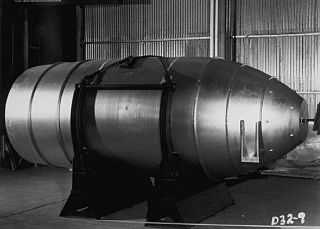 W
WThe Mark 14 nuclear bomb was a 1950s strategic thermonuclear weapon, the first solid-fuel staged hydrogen bomb. It was an experimental design, and only five units were produced in early 1954. It was tested in April 1954 during the Castle Union nuclear test and had a yield of 6.9 Mt. The bomb is often listed as the TX-14 or EC-14. It has also been referred to as the "Alarm Clock" device though it has nothing to do with the design by the same name proposed earlier by Edward Teller and known as the Sloika in the Soviet Union.
 W
WThe Mark 15 nuclear bomb, or Mk-15, was a 1950s American thermonuclear bomb, the first relatively lightweight thermonuclear bomb created by the United States.
 W
WThe Mark 17 and Mark 24 were the first mass-produced hydrogen bombs deployed by the United States. The two differed in their "primary" stages. They entered service in 1954, and were phased out by 1957.
 W
WThe Mark 18 nuclear bomb, also known as the SOB or Super Oralloy Bomb, was an American nuclear bomb design which was the highest yield fission bomb produced by the US. The Mark 18 had a design yield of 500 kilotons. Noted nuclear weapon designer Ted Taylor was the lead designer for the Mark 18.
 W
WThe Mark 21 nuclear bomb was a United States thermonuclear gravity bomb first produced in 1955. It was based on the TX 21 "Shrimp" prototype that had been detonated during the Castle Bravo test in March 1954. While most of the Operation Castle tests were intended to evaluate weapons intended for immediate stockpile, or which were already available for use as part of the Emergency Capability Program, Castle Bravo was intended to test a design which would drastically reduce the size and costs of the first generation of air-droppable atomic weapons.
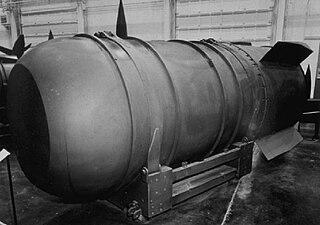 W
WThe Mark 36 was a heavy high-yield United States nuclear bomb designed in the 1950s. It was a thermonuclear bomb, using a multi-stage fusion secondary system to generate yields up to about 19 megatons.
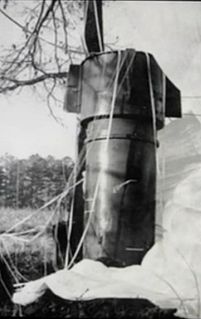 W
WThe Mark 39 nuclear bomb and W39 nuclear warhead were versions of an American thermonuclear weapon, which were in service from 1957 to 1966.
 W
WThe Mark 90 nuclear bomb, given the nickname "Betty", was a cold war nuclear depth charge, developed by the United States in 1952.
 W
WThe Mark 101 Lulu was an airdropped nuclear depth charge developed by the U. S. Navy and the Atomic Energy Commission during the 1950s. It carried a W34 nuclear warhead, with an explosive yield of about 11 kilotons. It was deployed by the U.S. Navy for the purposes of antisubmarine warfare, in at least five different models, from 1958 through 1971. These nuclear weapons were also stockpiled overseas at the bases of NATO allies, under American military guard and control, for the potential use by maritime patrol planes of NATO. Thus was most notable at the air base of RAF St. Mawgan in Cornwall, for potential use by British Avro Shackleton patrol planes and the Royal Netherlands Navy's P-2 Neptune and P-3 Orion patrol planes. Neither the Lulu nor any other kind of nuclear antisubmarine or antiship weapon was ever used in combat by any country.
 W
W"Thin Man" was the code name for a proposed plutonium gun-type nuclear bomb that the United States was developing during the Manhattan Project. Its development was abandoned when it was discovered that the spontaneous fission rate of nuclear reactor-bred plutonium was too high for use in a gun-type design due to the high concentration of the isotope plutonium-240.